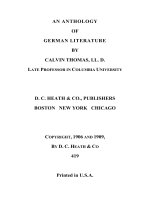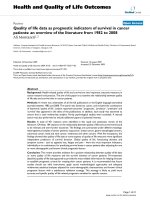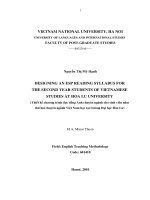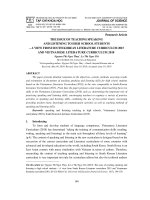An Ouline Of Vietnamese Literature
Bạn đang xem bản rút gọn của tài liệu. Xem và tải ngay bản đầy đủ của tài liệu tại đây (137.6 KB, 2 trang )
<span class='text_page_counter'>(1)</span><div class='page_container' data-page=1>
~ 1
<b>VIETNAMESE LITERATURE </b>
<b>Introduction </b>
Like the river basins that have nourished Vietnam's agricultural civilization for thousands of years, Vietnamese literature
has been fed by two great tributaries: the indigenous oral literature and the written literature of Chinese influence.
The oral poetry tradition is purely native. Older even than the linguistic separation of the Muong and Vietnamese
languages 1,000 years ago, the oral poetry tradition probably has its origins in the agrarian prayers common to the
prehistory of the Mon-Khmer language family. The oral poetry, still sung today in the countryside, remains a strong
influence in contemporary poetry and fiction writing. Its word stock, prosodic patterns, and themes show few foreign
influences. And, while its main contemporary feature is the lyrical, first-person, sung poetry of <i>ca dao</i> (“folk ballads”), the
oral tradition also contains third-person narratives, as in the <i>ca tru</i> (“ceremonial songs”) tradition in the north and the <i>vong </i>
<i>co</i> (“echoes of the past”) tradition in the south, as well as in the <i>tuc-ngu</i> proverbs (“customary words”), related to <i>ca dao</i>.
Chinese influence on the written literature of Vietnam is nearly as old as its conquest of the country in the 2nd century BC.
For nearly 2,000 years after that, most Vietnamese writing was in Chinese ideograms. In other words, to express
themselves in writing, the Vietnamese had to use a writing system that represented their ideas but not their speech.
However, with national independence and the establishment of a Vietnamese state in the 10th century AD, scholars began
to develop an ideographic writing system that represented Vietnamese speech. This demotic writing system, called Chu
Nom, or “the southern script,” existed beside Chinese writing into the early 20th century when both Chinese and Chu Nom
were supplanted by a Roman alphabetical script, first proposed in 1651 by the Jesuit priest Alexandre de Rhodes. The
alphabetical system of writing, called Quoc-ngu, or “the national script,” was much simpler to learn than either Chinese or
Chu Nom. Its general adoption, particularly in the late 19th and early 20th centuries, spread literacy throughout Vietnam
and sped the introduction of Western ideas and literary forms, including the appearance of the Western-style novel and
short story.
Along with the borrowed conventions of Chinese literature came Confucianism, Buddhism, and Daoism. Over the many
centuries of Chinese acculturation, these “Three Religions” grafted themselves, more or less successfully, onto similar,
indigenous habits of belief. The choice of writing in Han-Viet (Chinese-Vietnamese) or in Chu Nom gave individual
authors a wide range of formal and thematic possibilities, including the <i>luc-bat</i> (“six-eight,” referring to a basic couplet of
six syllables in the first line and eight in the second) prosody of the oral tradition. While concurring on the prestige of
Chinese writing, Vietnamese literati were intent on establishing the independence of Vietnamese writing, even as they
accepted models from the full range of Chinese literary forms, especially the “regulated verse” form, or <i>lüshi</i>, of the Tang
dynasty. Both in Chinese and in Chu Nom writing, <i>lüshi</i> (<i>tho duong luat</i> in Vietnamese) became the classical carrier of
lyrical expression. In its borrowed origins and in its formal compression, its cultural function was similar to that of the
English sonnet. The form reached aesthetic heights in Vietnamese hands in the 19th century, with poets such as the
concubine Ho Xuan Huong, who composed regulated verse poems that were complete double entendres, filled with tonal
puns (<i>noi lai</i>). Still others created regulated verse palindromes that would be in Vietnamese from start to finish but then,
going backward, ideogram by ideogram, became poems in Chinese, switching languages on the reversal. Perhaps the most
extraordinary proponent of this kind of virtuoso play was the emperor Thieu Tri (ruled 1841–47), who wrote a poem for
his intellectual recreation that was a circular palindrome offering 12 different readings. This poem, carved in jade inlay for
a wood panel at the Long-An Palace, can still be seen at the Imperial Museum of Hue.
In the earliest centuries of the independent Vietnamese nation, a great deal of the literature was produced by Buddhist
monks of the Thien school (a prior form of what is better known as Zen), which had reached Vietnam as early as the 2nd
century by means of Indian monks traveling to China. In the 10th and 11th centuries a collection of Buddhist biographies
and verse pronouncements entitled <i>Thien uyen tap anh</i> (literally “Flowers of the Garden of Thien,” more prosaically
“Outstanding Figures in the Zen Community”) included works by famous monks such as Van Hanh, Man Giac, Vien
Chieu, Vien Thong, Khong Lo, and others. In the late 13th century, with the Buddhist Truc Lam (“Bamboo Forest”) sect
under the patronage of King Tran Nhan Tong, this brand of Buddhism, as the state religion, was still the chief influence in
literature. However, as Confucianism of the Chinese administrative model became an increasingly more reliable tool in
governing and defending Vietnam, the locus of literary talent gradually shifted to high court officials and statesmen such
as Nguyen Trai in the 15th century or Nguyen Binh Khiem in the 16th.
Perhaps the greatest of these statesmen-poets was Nguyen Du in the 19th century. His <i>Truyen Kieu</i> (<i>The Tale of Kieu</i>), or
<i>Kim Van Kieu</i>, is generally considered the pinnacle of Vietnamese literature. Written in the Chu Nom vernacular in 3,253
<i>luc-bat</i> couplets of the oral folk tradition, <i>The Tale of Kieu</i> was immediately a great classical work and also a work, when
read aloud, that was accessible to the masses of Vietnamese who could not read or write. With its concerns for individual
freedom and its sense of karmic destiny, with its conflicts over Confucian versus Buddhist obligations, and with its
examination of <i>duyen</i> (“fated love”), this great work is the summation of the Vietnamese sense of self at the end of the
feudal period.
</div>
<span class='text_page_counter'>(2)</span><div class='page_container' data-page=2>
~ 2
appeared (Nguyen Trong Quan's "Truyen thay Lazaro Phien" [ "The Story of Lazaro Phien" ], 1887) and, in 1910, the first
Western-style novel (Tran Chanh Chieu's <i>Hoang To Anh ham oan</i> [“The Unjust Suffering of Hoang To Anh”]).
Twentieth-century Vietnamese literature was a chronicle of movements, evolutions, and revolutions as writers witnessed
the disappearance of their feudal past under French colonialism. With French control of the major part of Vietnam by
1862, Vietnamese writers struggled to find some intellectual system to address this drastic redefinition of the nation.
Movements to restore the throne met movements to abandon it altogether. When the Japanese defeated the Russians in
1905 and when the Chinese revolution met success in 1911 under Sun Yat-sen's leadership, the Vietnamese took note.
Early on, some Confucian reformists, such as Luong Van Can, Phan Boi Chau, and Phan Chau Trinh, proposed
cooperation with the French as they worked to establish a literature that could meet the needs of their changed world.
Some, such as Pham Quynh with his influential journal <i>Nam phong</i> (“South Wind”), accepted French rule as an
inevitability that might offer new thinking and writing. Still others envisioned only a literature of resistance.
Perhaps the two most influential literary movements, when one considers their lasting effect, were the Tu Luc Van Doan
(“Independent Literary Group”), led by Khai Hung and Nhat Linh, and the Tho Moi (“New Poetry”) school, which
included important writers such as Xuan Dieu, Che Lan Vien, Cu Huy Can, Bang Ba Lan, and Luu Trong Lu. Both groups
succeeded in throwing off antiquated Chinese literary habits, creating a new and lively literature in Quoc-ngu, the former
in prose and the latter in poetry. Their differences in defining Vietnamese nationalism would lead to further extremes of
right and left in later years. This ferment in the “national script” also swept into the essentially new medium of journalism,
which afforded great access to the Vietnamese people. Indeed, in 1938, after the French had lifted censorship on the eve of
World War II, there were 128 daily newspapers in Vietnam.
With the establishment of the Popular Front in France, the ideological rift widened between literary movements. Those
who followed communism sought a new realism akin to the Socialist Realism of Soviet Russia. With the success of the
Viet Minh and the abdication of Emperor Bao Dai in August 1945, the current stage was set: in the North, a form of
Socialist Realism became the orthodoxy, both in poetry and prose, yet there were notable nonconforming poets such as
Xuan Dieu, Che Lan Vien, Te Hanh, as well as To Huu, who served as the poet of the Marxist viewpoint. In the South,
under American influence after 1954, many writers, such as Vo Phien and Doan Quoc Sy, struggled on with their
independent voices.
With the end of the war in 1975, gifted, startling, and, sometimes, dissident writers emerged in works that often found
Western readers. Although significant poets such as Nguyen Duy were among this new group, it was largely prose fiction
that marked the lively postwar period, with novels such as Duong Thu Huong's <i>Tieu thuyet vo de</i> (1991; <i>Novel Without a </i>
<i>Name</i>), Bao Ninh's <i>Than phan cua tinh yeu</i> (1991; <i>The Sorrow of War</i>), and Nguyen Huy Thiep's remarkable collection
<i>Tuong ve huu</i> (1988; <i>The General Retires and Other Stories</i>).
At the turn of the 21st century, a second generation of writers had emerged abroad, especially in the United States,
including Nguyen Qui Duc (<i>Where the Ashes Are</i>, 1994); Andrew Lam, co-editor of <i>Once upon a Dream: The </i>
<i>Vietnamese-American Experience</i> (1995); Monique Truong, <i>The Book of Salt</i> (2003); and Le Thi Diem Thuy, <i>The </i>
<i>Gangster We Are All Looking for</i> (2003). There remained in Vietnamese literature, wherever one found it, traces of French
Symbolism and of a renovated Socialist Realism. In poetry frequent use of free verse occurred. Postmodernism and even
magic realism had become available literary strategies. All these blended into the ancient streams of Vietnamese literary
habit, which had by no means disappeared. John Balaban
<b>Additional Reading </b>
<b>Works of general interest </b>
Maurice M. Durand and Nguyen Tran Huan, <i>An Introduction to Vietnamese Literature</i> (1985), trans. by D.M. Hawke, is
one of the few general surveys available in English. Pierre Huard and Maurice Durand, <i>Viet-Nam, Civilization and </i>
<i>Culture</i>, trans. by Vu Thien Kim, rev. 3rd ed. (1998; originally published in French, 1954), is an English translation of the
famous compendium <i>Connaissance du Vỵetnam</i>; it is filled with ethnographic, historical, and cultural details, including the
literary arts. John Balaban (ed. and trans.), <i>Ca Dao Vietnam: Vietnamese Folk Poetry</i> (2003), includes an introduction to
the oral tradition, followed by 73 poems, recorded, transcribed, and translated in 1971–72. John C. Schafer, <i>Vietnamese </i>
<i>Perspectives on the War in Vietnam: An Annotated Bibliography of Works in English</i> (1997), gives through translated
works a detailed description of war literature from Vietnamese perspectives. Khac Vien Nguyen and Huu Ngoc (eds.),
<i>Vietnamese Literature</i>, trans. by Mary Cowan (1982; originally published in French, 1964), presents translated poetry and
prose along with precise biographies of the authors from the founding of the nation in the 10th century to the modern
period; it contains interesting (if faint) photographs of landscapes, authors, and monuments.
<b>Anthologies </b>
John Balaban and Nguyen Qui Duc (eds.), <i>Vietnam</i> (1996), comprises 17 short stories by contemporary authors living in
Vietnam, Europe, and the United States, including several by northerners who became known in the West in the postwar
Renovation period. Sanh Thong Huynh (ed. and trans.), <i>An Anthology of Vietnamese Poems from the Eleventh Through </i>
<i>the Twentieth Centuries</i> (1996, reissued 2001), comprises poetry from the 11th through the 20th century. Wayne Karlin,
Le Minh Khue, and Truong Vu (eds.), <i>The Other Side of Heaven: Post-war Fiction by Vietnamese and American Writers</i>
</div>
<!--links-->









